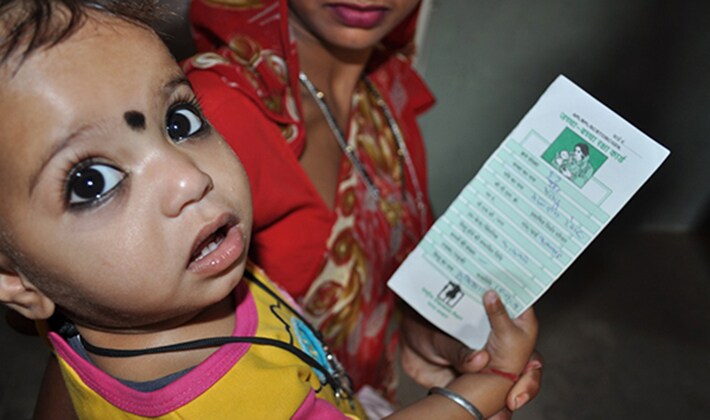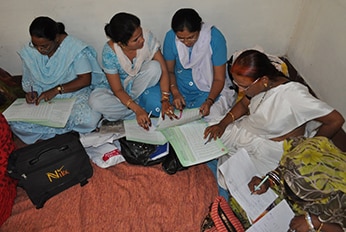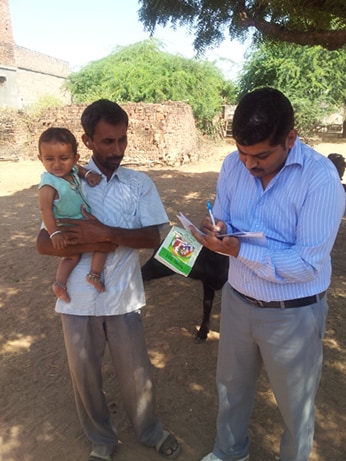Strengthening Capacity: Keeping it Simple and Realistic in India
January 2, 2015
Updated April 20, 2023
This web page is archived for historical purposes and is no longer being updated.

A child holding his vaccination card at a health facility in Rajasthan, India. Credit: Steve Stewart, CDC.
India is a big, bustling, multidimensional place, full of achievements that are both impressive and surprising. India, for example, is the largest democracy in the world and has the world’s largest postal system, the longest road network, and the most English speakers of any country on Earth.
But it is also home to some sobering “mosts.”
Here’s one: India has the most children in the world—an astounding 6.9 million—who are not protected by vaccines against deadly diseases such as measles, rubella, diphtheria, tetanus, and whooping cough. That number amounts to one-third of all unimmunized kids worldwide.
That fact—and the consequences for the health of Indian children—brought together UNICEF, the Government of India, and CDC’s Global Immunization Division (GID) to figure out how to solve the problem.
It is a good partnership. India had a large number of health workers and a strong commitment to vaccinate children, but in a number of Indian states the health system simply was not prepared to deliver all needed vaccinations to infants, children, and adults. All partners agreed that the skills of health workers and the system to get these vaccines to children had to improve.
The partners began sharing their experience and expertise to reach the goal: to build a system and put practices in place that would lead to long-term success in delivering lifesaving vaccinations to India’s children. India’s government acknowledged that immunizing more children would require management and service delivery staff at all levels (state, district, sub-district) to improve their use of available information and implement stronger policies. With such a large task at hand, the government proposed starting intensive work in just one state, Rajasthan, to strengthen its routine immunization (RI) system. Then, if all went well there, this work could be expanded to other states.
It was a logical choice. The state of Rajasthan is home to 68 million people and has one of the highest percentages of children who either had not received all vaccinations or had not been protected from some of the diseases that vaccinations can prevent. Also, the nearly 20,000 health workers in Rajasthan were in need of greater skills so they could better protect children—skills such as monitoring vaccination status and mobilizing families to seek vaccination, reporting on disease occurrence, analyzing population vaccination coverage, and planning effective immunization sessions.
Capacity Building Initiative – Routine Immunization (CBI-RI)
In simplest terms, the effort in Rajasthan aims to increase vaccination of children and women by improving key workforce practices, including
- In-service and on-the-job training, including management workshops to introduce new activities
- Supervision and program review to identify bottlenecks that contribute to poor program implementation
- Use of improved information for making decision and creating specific action plans to address challenges
The goal was to continuously improve the ability of healthcare workers to identify and vaccinate children and women who need vaccines to protect against deadly and disabling diseases.
Unique features of CBI-RI approach:
- Institutionalizes interactive in-service training through existing monthly meetings and supervisory visits
- Links training directly to continuous improvement of the RI system
The CBI-RI project was designed to be simple by first conducting brief cascaded training for managers and health workers. At regular meetings, participants engage in practical exercises to strengthen specific RI system practices at each level and then complete assignments based on actual work to implement the practices. Supervisors review assignments during field supervision and subsequent meetings to ensure the information is being used to improve services and policies. Brief activity modules (see box below) are used to guide the process. Incorporating the CBI-RI activities with regular field supervision visits and meetings is intended to strengthen those management processes, making the approach more realistic and sustainable. It also helps managers address identified gaps in supervision and review processes. For example, an early assessment during CBI-RI implementation found that reviews were not regularly occurring at the health facility level during monthly meetings with vaccinators and supervisors. Other gaps in how meetings were conducted were identified, and specific guidelines were created for conducting reviews in monthly meetings and providing additional training for new medical supervisors.
The initiative began in a phased manner. In the first phase, the strategy was developed and carried out in 5 of the 33 districts. After one year, the government decided to expand the implementation statewide. During this phase, CDC worked with UNICEF and the Government of Rajasthan to conduct a needs assessment of system practices, develop the CBI-RI strategy, develop activity modules using existing policies and training materials, and test implementation methods. CDC also helped monitor and evaluate implementation and outcomes and provided recommendations to improve the CBI-RI approach.
Example Activity Module: Reaching children and women due for vaccines
Teaching with demo and exercise: Teach the team about identifying women and children who are due and past-due for vaccinations. Show how to use the service delivery registry, tracking bag and due list tools to ensure a complete list of those who need services. Using a sample service delivery register, complete the tracking bag and due list to identify and then mobilize missed women and children.
Assignment: Complete the cards for the tracking bag and then the due list based on your own service delivery registry and use for mobilizing beneficiaries for your next vaccination session.
Supervision: Review service delivery registers, cards and due list book and verify that all women and children are included. Provide on-the-job training [on what?] to the vaccinators.
Review in next meeting: Manager and/or supervisor reviews a sample of vaccinator’s due lists for completeness in front of the group and discusses any gaps in knowledge or practices. At higher level supervisor review meetings, summarize supervisor findings and key challenges about the tracking process to be addressed. Provide further training on… if needed.
Decision-making/action: Use the information from review and supervision to address gaps in tracking and more effectively monitor coverage. Ensure the ongoing and improved use of the tools.
Signs of success
While the full reach of the CBI-RI approach is still evolving, the early signs of success are apparent. The Government of Rajasthan has clearly owned this new process for in-service training. When two new policies were implemented in 2014 for reducing vaccine wastage and introducing the 5-in-1 vaccine (against diphtheria, tetanus, whooping cough, Hib disease and hepatitis B), the Government of Rajasthan developed two new activity modules to guide managers, supervisors and vaccinators on their use. Now, they are developing new activity modules for improving antenatal care services.
UNICEF touts the use of concepts from CBI-RI (use of information, supervision and continuous improvement) in another approach to improving maternal and child health services. Mentors play an especially important role as well—after training, they visit health facilities multiple times to provide the staff with supportive supervision and on-the-job training on critical maternal and newborn care services. The mentors then help review the process and participate in additional training as needed.
Feedback
One retired senior government official who participated in the evaluation of the pilot said that this was the first time in his career he had seen such a practical skill-building activity in which direct outcomes were being measured. Another government official added, “With only a couple of hours in a month, we can change how our system works.”
Partners collectively believed that creating the opportunity for sustainable change required starting simple and being persistent. But there are no shortcuts. Recent monitoring and evaluation activities found that in-service training had widespread reach, yet still needed a stronger focus on management practices. Although training exercises are regularly conducted, there is little evidence that the system practices—supervision and review of the regular assignments—are being carried out as planned. To achieve the objectives for further improving these key system practices, partners must ensure that they are consistently carried out within the CBI-RI. Fortunately, the Government, UNICEF and CDC are invested in this effort and understand the amount of time it takes to demonstrate success. As one manager put it simply, “This is about changing habits, and it will take time.”
What’s next?
What started as a pilot project became a statewide initiative in Rajasthan, and now the idea is spreading. On the eastern side of India, the State of Jharkhand and UNICEF, with input from CDC, are scaling up the CBI-RI approach. The overall approach and activity module topics were adapted or developed based on state-specific priorities. The CDC team’s Alice Pope feels hopeful for the sustained success and growth of the initiative in Rajasthan, Jharkhand and other countries. The legacy of this work will be the ability for a health system to continually improve the quality of its vaccine delivery and day-to-day practices (in-service training, use of information, supervision, analysis and review) over time.
The government conventionally provides training in large batches, which takes years to implement in these large states with over 20,000 health workers, and the evaluations often find poor retention of the information. In-service training is so needed. Implementation is happening and although it isn’t perfect, this use of information training which focuses on key practices can actually reach all health managers and workers within 2-3 months and has potential for reaching a tipping point for institutionalizing capacity building and thereby creating a new organizational culture. That is an amazing accomplishment.

Auxiliary nurse-midwives practice developing annual immunization plan during regular meeting. Photo courtesy of Steve Stewart, CDC.

Division coordinator checking village vaccination status for feedback to auxiliary nurse-midwife. Photo courtesy of Alice Pope, CDC.